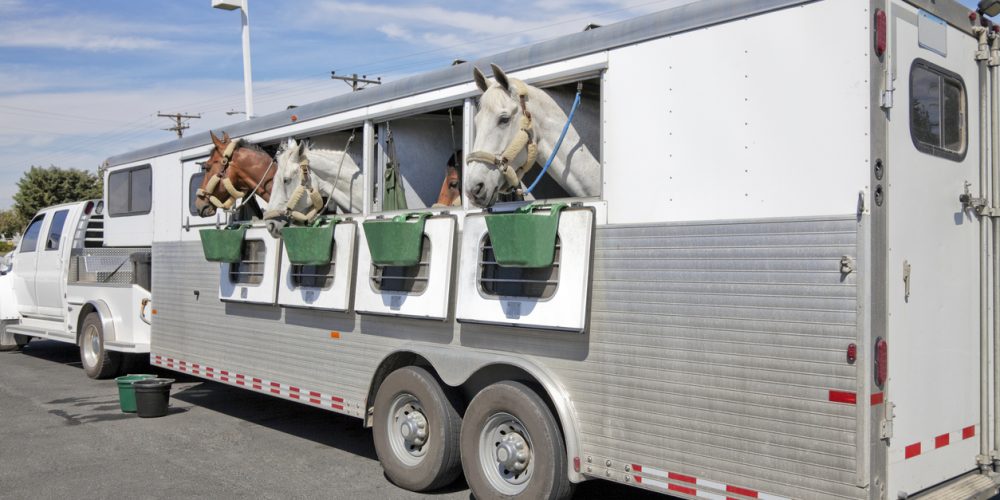Getting ready to purchase a horse trailer? There’s a lot to consider: among other things, the safety of your horse or horses, over-the-road comfort for you both and the financial investment required for this added mobility. Buyers are faced with seemingly unlimited choices in size, style and price points for new or used trailers alike. How do you choose one that is right for you? These descriptions and tips may help.
Should I buy a new or used trailer?
Used trailers can be a good option for new buyers. Obviously, if you find one that has all the features you want, is in good condition, fits your lifestyle and your budget as well, it is simply your best choice. It’s also a great way for first-time buyers to determine just how often the trailer will get used and what features you like – or dislike – before you commit to spending more money for a new one.
On the other hand, horse trailer manufacturers have continued to develop lighter, stronger, more efficient products and many safety features have been improved. A well-built, well-equipped new trailer that can last you for the next 15-25 years is pretty much a no-lose proposition, so the biggest issue in determining your choice will most likely be the price point.
Making the safety-first choice
Selecting a unit that will keep both you and your horse safe is a critical consideration. On used trailers, watch for exposed sharp edges or protrusions and worn flooring. New ones should offer sturdy walls, with solid underfloor bracing, high-quality latches and strong, secure gates. Check, too, for adequate ventilation: sliding windows and overhead roof vents are a must. Other concerns, such as loading safety and transport issues are covered in our review of trailer sizes and styles.
Is it the right size for your horse?
Determining the proper trailer size for your horses will help to ensure that they enjoy safe, stress-free travel. If, for example, the space is larger than you need, your horse will be able to shift around too much during transport, creating potentially dangerous instability; conversely, if the trailer is too small, it will be cramped and uncomfortable, causing them stress. The first step in the purchase process is to consider the height, weight and breed of your horse. Measure from tip to tail and shoulder to shoulder to know the animal’s precise size before you shop. To ride securely, your horse needs to be able to spread its legs and have room to use its head and neck for balance.
When you do find a trailer that interests you, inspect it carefully; in some cases, ones with a curved roof may be advertised noting the peak as its actual height; in transport, however, your horse’s head may end up closer to the outside wall – which could be confining and far less comfortable. At the same time, check the wheel wells; they can compromise standing room as well.
Is it the right size for you too?
While the safety and comfort of your horse is paramount, the trailer that best fits your needs must also be able to tow safely behind your vehicle, store your gear securely and even, perhaps, provide relaxing living quarters when you are on the road. Again, choices abound:
- Bumper-towed trailers are the simplest and least expensive models, but they may not be up to the weight of your load and offer limited storage. On the plus side, the lightest bumper-towed trailers can be towed by a wide range of small trucks or SUVs. And, since most bumper-pull combinations will weigh under 10,001 pounds Gross Combination Vehicle Weight Rating (GCVWR), you won’t have to register your rig as a “commercial” vehicle. Trailer parking and storage is easier, too, due to its compact size. What you sacrifice, however, is space for gear and feed.
- Gooseneck trailers, which connect to pickup trucks with a bed-mounted ball hitch, offer greater stability and weight distribution. Because the trailer starts turning when the truck turns, the turning radius is much tighter, allowing you greater ability to maneuver in tight spaces than with a bumper-towed unit. Many can be purchased with tack room space or built-in feed storage. Because gooseneck trailer combinations will be over 10,001 pounds GCVWR, you may have to license your rig as commercial.
- Trailers with living quarters generally offer more than adequate space for owners as well as for multiple horses and even full tack rooms. These units can be outfitted with luxurious motorhome-like features or provide simple no-frills quarters. They are the most expensive option and generally require a heavy-duty towing vehicle.
Choosing the ideal style
Selecting the right trailer style for your particular needs can make the entire travel experience safer and more pleasurable for both you and your horse. There are three primary styles – manger, walk-through or slant-load. Here’s a look at each:
- Manger: Manger-style trailers offer a built-in hay manger, with storage underneath. While a trailer with a fixed manger may sound convenient (and the storage area beneath the manger appealing), it may be problematic for your horse, who could spend long hours inhaling dust and debris from the hay and feed below. The manger can also take up valuable space, inhibiting your horse’s ability to move its legs and head to balance when you come to a stop. Personal safety can also be a concern; in a one-sided manger style, the loader can easily step aside once the horse has reached the front. One that stretches the entire width of the trailer, however, can trap someone loading a second horse.
- Walk-through trailers: These are the simplest trailers for onboarding. The horse walks on behind the handler, who can then exit through a full-size door at the front (or side) of the trailer. While space for tack and feed may be limited in smaller walk-throughs, the design gives the horse room to brace, while giving the handler a quick escape route if needed.
- Slant-load trailers: If you need to haul more than one or two horses, consider a slant-load trailer. Although not always suitable (especially for larger breeds), the slant-load layout makes it possible to haul more horses with a compact trailer. Before purchase, however, consider these potential negatives: the wheel wells often take up valuable floor space and horses traveling at an angle may have difficulty absorbing the shocks from rough road surfaces.
Deciding between a ramp or step-up trailer
While step-up horse trailers are the “standard” version for many builders, many with a built-in ramp are also available. Ramps are generally safer for both you and your horse, but have their own drawbacks. Before you purchase one with a ramp, make sure that it lifts easily, is spring assisted and that any gap between the ramp and trailer is small. A significant opening between the mat and ramp edge may be enough to catch – or even remove – horseshoes. It’s a good idea, too, to look for ramps that are positioned on the outside of full-height doors. This style keeps you from being inadvertently kicked when you lift the ramp and adds an extra layer of protection in the event of a rear-end collision. Trailers with front unload ramps are generally the best alternative, notwithstanding price.
Step-up trailers are, on the whole, less expensive, and most feature a step height that is easy for your horse to navigate. Most step-up trailers also reduce the possibility of your horse slipping while entering the trailer. Remember, though, that the best step-up trailer is one that’s wide enough to allow your horse to turn around and unload head first, instead of having to back out.
The bottom line
Whether it’s new or used, buying that first horse trailer can be pretty challenging. Take time to review the various options so that you can make the best decision for you and your horse. If you know other owners who have a trailer type you are interested in, be sure to ask questions – particularly ones concerning their satisfaction with the purchase.
One part of this process, however, is a lot simpler than you might think – when it comes to financing, First Internet Bank provides affordable loans for new and used trailers. Best of all, you can apply easily online in minutes. Love the freedom you feel riding your horse? Just imagine how much more the ability to go anywhere with your new trailer will add to the experience.





